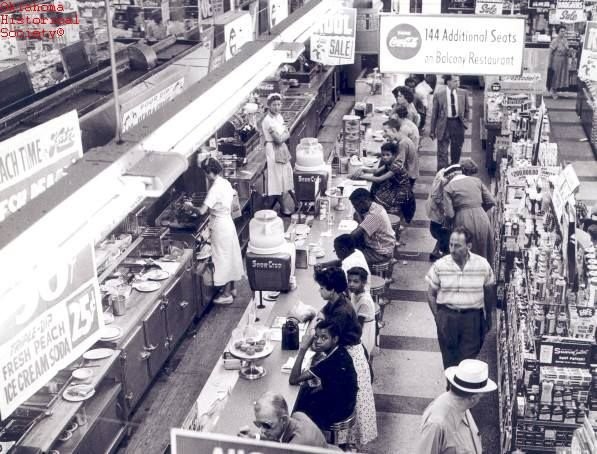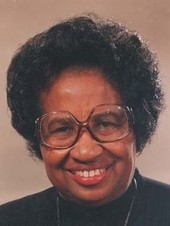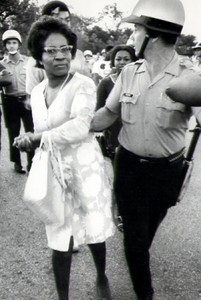Katz Drug Store Sit-In (1958)
Introduction
Text-to-speech Audio
One of the first civil rights sit-ins in the Southern Great Plains occurred at this location, as over a dozen youth and adults waged a protest at the Katz drugstore lunch counter for three days between August 19th and 21st in 1958. The effort was led by local high school teacher Clara Luper, who served as an advisor for the Oklahoma City branch of the NAACP Youth Council. Together with vice president Barbara Ann Posey, area students, and members of the community, the protesters trained for the event and endured threats and violence for hours over three consecutive days. The protesters stoically sat at the Katz drug store lunch counter and endured insults, threats, and violence until the third day, when they were finally offered service. The event inspired many additional efforts to challenge racial discrimination throughout Oklahoma City and beyond, with additional protests led by Clara Luper who was arrested 26 times in her life for protesting against racial discrimination. The efforts of Luper and other community members culminated in a 1964 city ordinance against racial discrimination in public accommodations. In March 2022, area leaders announced that the event would be memorialized by a public sculpture dedicated in honor of the sit-ins that would be dedicated at this location following fundraising efforts.
Images
The sit-in began on August 28, 1958, at Katz Drug Store in Oklahoma City and ended when the store manager agreed to serve all patrons at the counter.

Clara Luper was the advisor for the Youth Council of the NAACP in Oklahoma City at the time of the sit-in movement.

Clara Luper is pictured here being restrained by a police officer at one of the many demonstrations that she was a part of.

Backstory and Context
Text-to-speech Audio
African Americans in Oklahoma City held many meetings where they discussed strategies for confronting the racial discrimination they faced in the early 1950s. Clara Luper, a local teacher and the advisor of the Oklahoma City branch of the NAACP Youth Council, along with Barbara Ann Posey, the vice president of the branch, led the council in the decision to begin sit-ins at lunch counters. They targeted the Katz drug store due to its prominent location and well-known discriminatory policies after the manager refused their request to serve all people at the lunch counter. On August 19, 1958, the group of civil rights activists sat down at the Katz lunch counter and ordered sodas. Service was refused, as was expected, and the protesters sat quietly, filling the seats of the lunch counter for the next few days. On the third day, the store manager decided to serve the group.
Together with a successful sit-in in Wichita, Kansas, in July and August 1958, African American communities in Kansas and Oklahoma were at the vanguard of a growing movement of direct action campaigns. Dr. Martin Luther King Jr. publicly acknowledged the achievement of the Oklahoma City Youth Council by awarding them citations at the NAACP convention in 1959, and the sit-ins in both states have been the subject of multiple articles and books that are also linked below.
In recognition of these events, both Wichita and Oklahoma City are adding markers and monuments to their downtown landscapes. The 2022 plan for the Oklahoma City monument includes both a lunch counter and figures of the thirteen participants. Articles on the event tend to emphasize the centrality of Clara Luper and her children. Luper was not only an advisor for the Youth Council, she joined her own children in the sit-in. She was also an influential teacher who served the city schools for forty-one years and became the first African American woman in the graduate program in history at the University of Oklahoma, where she received her master’s degree. Researchers can view Luper’s collection of scrapbooks, photographs, and papers at the Oklahoma Historical Society.
Sources
Walters, Ronald. “THE GREAT PLAINS SIT-IN MOVEMENT, 1958-60.” Great Plains Quarterly, vol. 16, no. 2, 1996, pp. 85–94. JSTOR, JSTOR, www.jstor.org/stable/23531753.
Decker, Stefanie Lee. “Luper, Clara Shepard | The Encyclopedia of Oklahoma History and Culture.” Cheyenne, Southern | The Encyclopedia of Oklahoma History and Culture, http://www.okhistory.org/publications/enc/entry.php?entry=LU005
Reese, Linda W. “Jones, Barbara Ann Posey (1943 - ) | The Black Past: Remembered and Reclaimed.” Boley, Oklahoma (1903- ) | The Black Past: Remembered and Reclaimed, Blackpast.org/aah/jones-barbara-ann-posey-1943.
“Clara Luper Changed Oklahoma Policy's.” African American Registry, aaregistry.org/story/clara-luper-changed-oklahoma-policys/.
“Greensboro Sit-Ins (1960).” Boley, Oklahoma (1903- ) | The Black Past: Remembered and Reclaimed, Blackpast.org/aah/greensboro-sit-ins-1960.
Stefanie Lee Decker, “Luper, Clara Shepard,” The Encyclopedia of Oklahoma History and Culture, https://www.okhistory.org/publications/enc/entry?entry=LU005
